FIAT IDEA 2007 1.G Owners Manual
Manufacturer: FIAT, Model Year: 2007, Model line: IDEA, Model: FIAT IDEA 2007 1.GPages: 314, PDF Size: 4.78 MB
Page 161 of 314
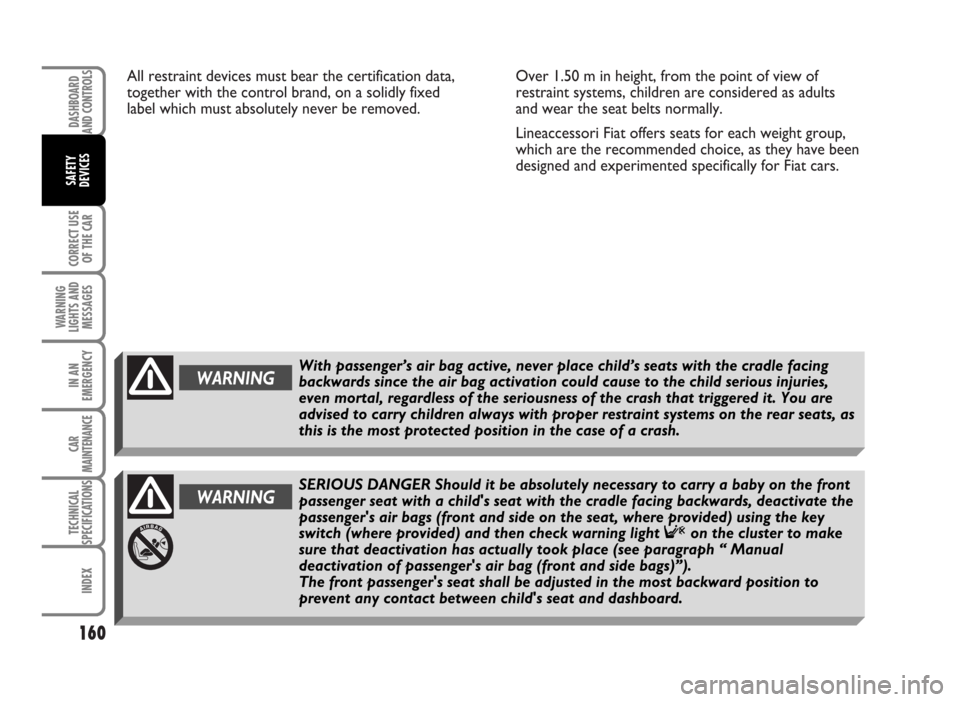
All restraint devices must bear the certification data,
together with the control brand, on a solidly fixed
label which must absolutely never be removed.Over 1.50 m in height, from the point of view of
restraint systems, children are considered as adults
and wear the seat belts normally.
Lineaccessori Fiat offers seats for each weight group,
which are the recommended choice, as they have been
designed and experimented specifically for Fiat cars.
160
CORRECT USE
OF THE CAR
WARNING
LIGHTS AND
MESSAGES
IN AN
EMERGENCY
CAR
MAINTENANCE
TECHNICAL
SPECIFICATIONS
INDEX
DASHBOARD
AND CONTROLS
SAFETY
DEVICES
WARNINGWith passenger’s air bag active, never place child’s seats with the cradle facing
backwards since the air bag activation could cause to the child serious injuries,
even mortal, regardless of the seriousness of the crash that triggered it. You are
advised to carry children always with proper restraint systems on the rear seats, as
this is the most protected position in the case of a crash.
WARNINGSERIOUS DANGER Should it be absolutely necessary to carry a baby on the front
passenger seat with a child's seat with the cradle facing backwards, deactivate the
passenger's air bags (front and side on the seat, where provided) using the key
switch (where provided) and then check warning light Fon the cluster to make
sure that deactivation has actually took place (see paragraph “ Manual
deactivation of passenger's air bag (front and side bags)”).
The front passenger's seat shall be adjusted in the most backward position to
prevent any contact between child's seat and dashboard.
Page 162 of 314
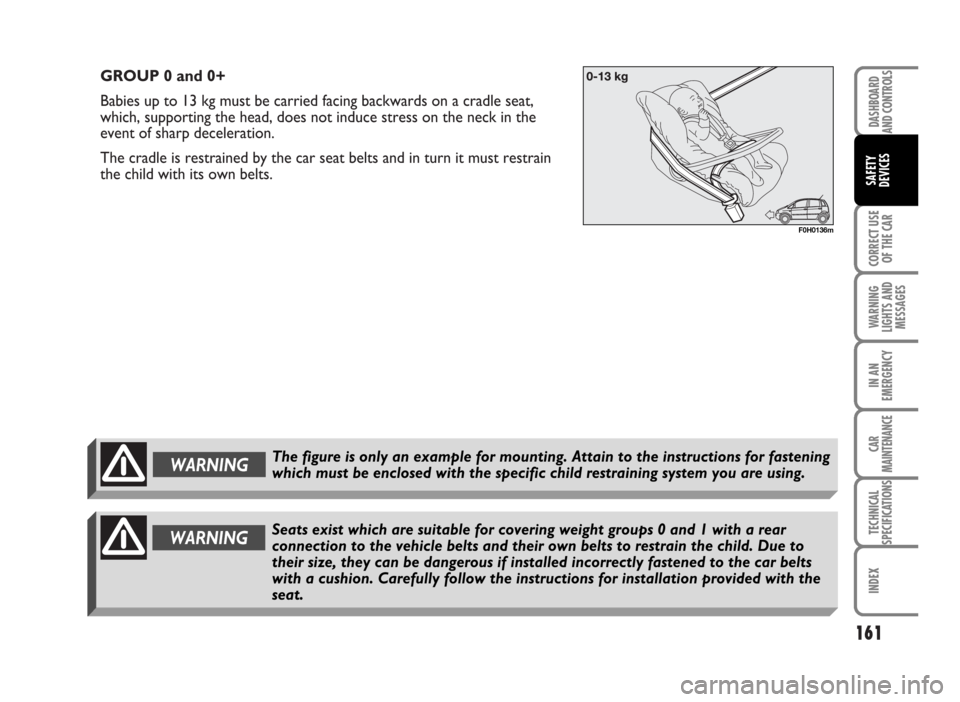
GROUP 0 and 0+
Babies up to 13 kg must be carried facing backwards on a cradle seat,
which, supporting the head, does not induce stress on the neck in the
event of sharp deceleration.
The cradle is restrained by the car seat belts and in turn it must restrain
the child with its own belts.
161
CORRECT USE
OF THE CAR
WARNING
LIGHTS AND
MESSAGES
IN AN
EMERGENCY
CAR
MAINTENANCE
TECHNICAL
SPECIFICATIONS
INDEX
DASHBOARD
AND CONTROLS
SAFETY
DEVICES
F0H0136m
WARNING
WARNINGSeats exist which are suitable for covering weight groups 0 and 1 with a rear
connection to the vehicle belts and their own belts to restrain the child. Due to
their size, they can be dangerous if installed incorrectly fastened to the car belts
with a cushion. Carefully follow the instructions for installation provided with the
seat. The figure is only an example for mounting. Attain to the instructions for fastening
which must be enclosed with the specific child restraining system you are using.
Page 163 of 314
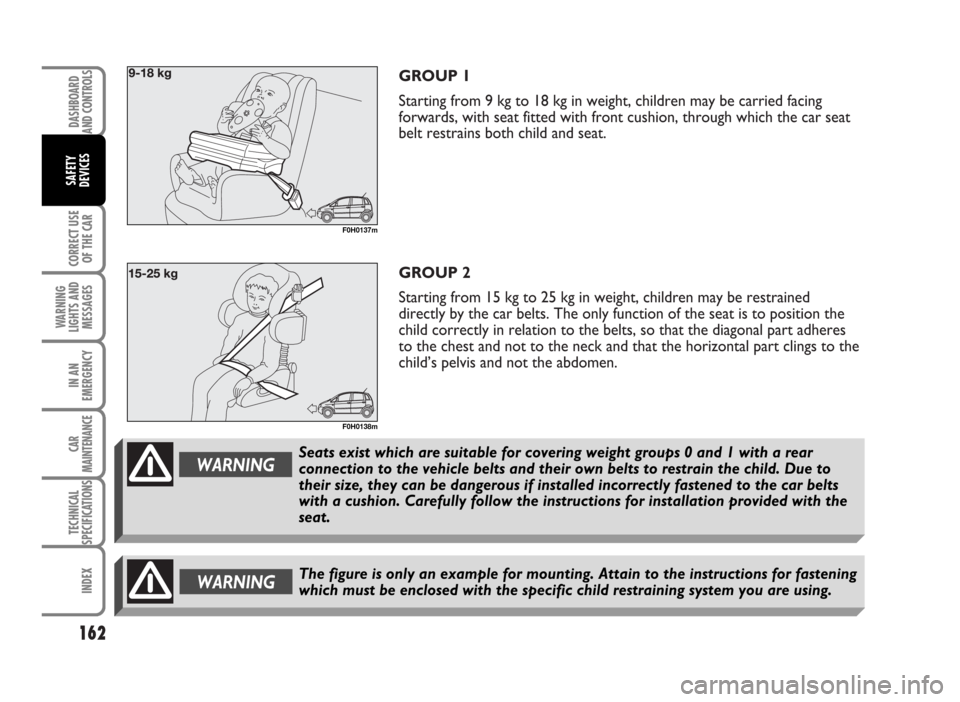
GROUP 1
Starting from 9 kg to 18 kg in weight, children may be carried facing
forwards, with seat fitted with front cushion, through which the car seat
belt restrains both child and seat.
GROUP 2
Starting from 15 kg to 25 kg in weight, children may be restrained
directly by the car belts. The only function of the seat is to position the
child correctly in relation to the belts, so that the diagonal part adheres
to the chest and not to the neck and that the horizontal part clings to the
child’s pelvis and not the abdomen.
162
CORRECT USE
OF THE CAR
WARNING
LIGHTS AND
MESSAGES
IN AN
EMERGENCY
CAR
MAINTENANCE
TECHNICAL
SPECIFICATIONS
INDEX
DASHBOARD
AND CONTROLS
SAFETY
DEVICES
F0H0137m
F0H0138m
WARNING
WARNINGSeats exist which are suitable for covering weight groups 0 and 1 with a rear
connection to the vehicle belts and their own belts to restrain the child. Due to
their size, they can be dangerous if installed incorrectly fastened to the car belts
with a cushion. Carefully follow the instructions for installation provided with the
seat.
The figure is only an example for mounting. Attain to the instructions for fastening
which must be enclosed with the specific child restraining system you are using.
Page 164 of 314
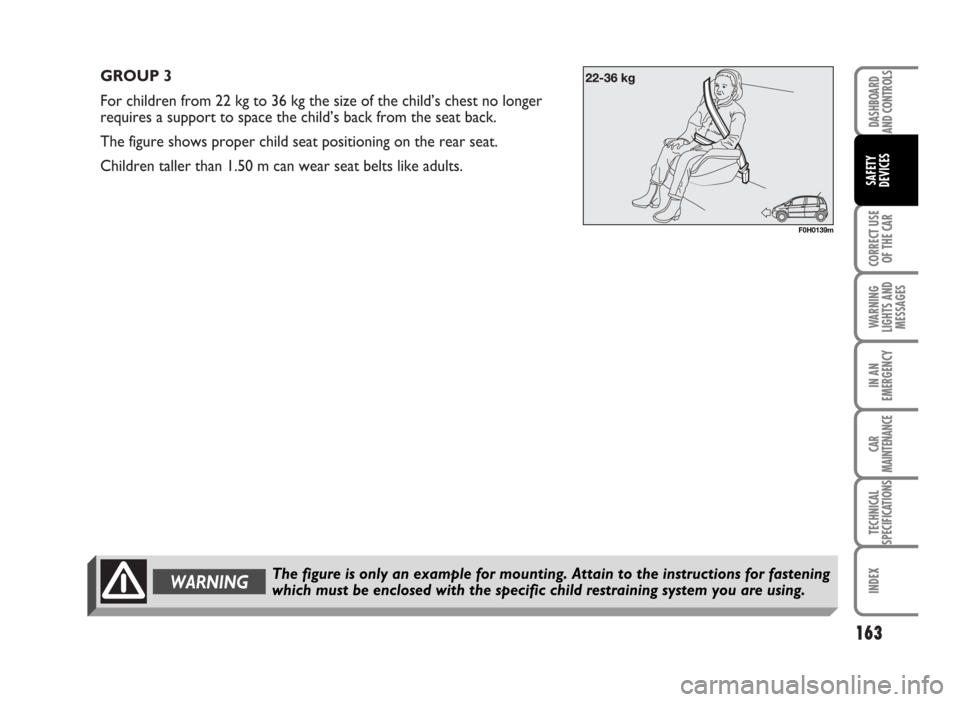
GROUP 3
For children from 22 kg to 36 kg the size of the child’s chest no longer
requires a support to space the child’s back from the seat back.
The figure shows proper child seat positioning on the rear seat.
Children taller than 1.50 m can wear seat belts like adults.
163
CORRECT USE
OF THE CAR
WARNING
LIGHTS AND
MESSAGES
IN AN
EMERGENCY
CAR
MAINTENANCE
TECHNICAL
SPECIFICATIONS
INDEX
DASHBOARD
AND CONTROLS
SAFETY
DEVICES
F0H0139m
WARNINGThe figure is only an example for mounting. Attain to the instructions for fastening
which must be enclosed with the specific child restraining system you are using.
Page 165 of 314
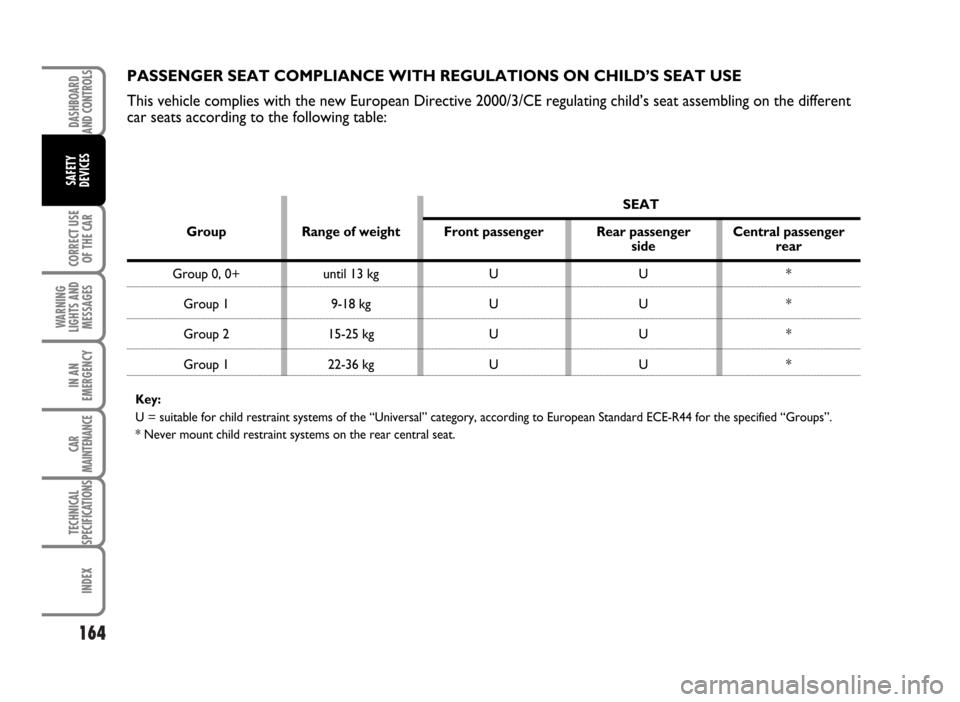
164
CORRECT USE
OF THE CAR
WARNING
LIGHTS AND
MESSAGES
IN AN
EMERGENCY
CAR
MAINTENANCE
TECHNICAL
SPECIFICATIONS
INDEX
DASHBOARD
AND CONTROLS
SAFETY
DEVICES
PASSENGER SEAT COMPLIANCE WITH REGULATIONS ON CHILD’S SEAT USE
This vehicle complies with the new European Directive 2000/3/CE regulating child’s seat assembling on the different
car seats according to the following table:
SEAT
Group Range of weight Front passenger Rear passenger Central passenger
side rear
Group 0, 0+ until 13 kg U U *
Group 1 9-18 kg U U *
Group 2 15-25 kg U U *
Group 1 22-36 kg U U *
Key:
U = suitable for child restraint systems of the “Universal” category, according to European Standard ECE-R44 for the specified “Groups”.
* Never mount child restraint systems on the rear central seat.
Page 166 of 314
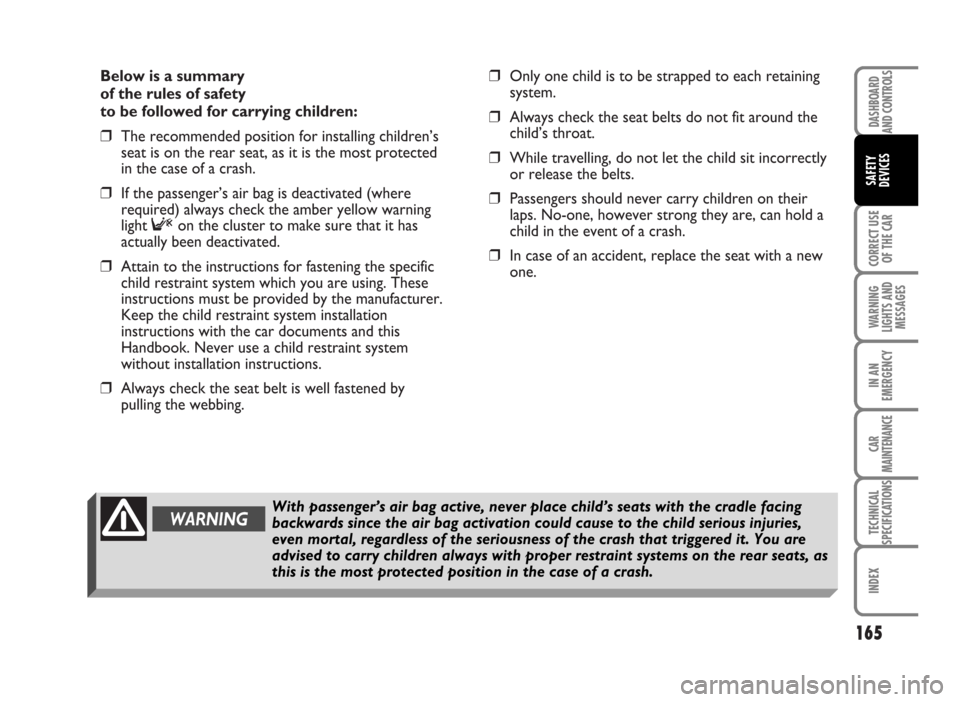
Below is a summary
of the rules of safety
to be followed for carrying children:
❒The recommended position for installing children’s
seat is on the rear seat, as it is the most protected
in the case of a crash.
❒If the passenger’s air bag is deactivated (where
required) always check the amber yellow warning
light Fon the cluster to make sure that it has
actually been deactivated.
❒Attain to the instructions for fastening the specific
child restraint system which you are using. These
instructions must be provided by the manufacturer.
Keep the child restraint system installation
instructions with the car documents and this
Handbook. Never use a child restraint system
without installation instructions.
❒Always check the seat belt is well fastened by
pulling the webbing.❒Only one child is to be strapped to each retaining
system.
❒Always check the seat belts do not fit around the
child’s throat.
❒While travelling, do not let the child sit incorrectly
or release the belts.
❒Passengers should never carry children on their
laps. No-one, however strong they are, can hold a
child in the event of a crash.
❒In case of an accident, replace the seat with a new
one.
165
CORRECT USE
OF THE CAR
WARNING
LIGHTS AND
MESSAGES
IN AN
EMERGENCY
CAR
MAINTENANCE
TECHNICAL
SPECIFICATIONS
INDEX
DASHBOARD
AND CONTROLS
SAFETY
DEVICES
WARNINGWith passenger’s air bag active, never place child’s seats with the cradle facing
backwards since the air bag activation could cause to the child serious injuries,
even mortal, regardless of the seriousness of the crash that triggered it. You are
advised to carry children always with proper restraint systems on the rear seats, as
this is the most protected position in the case of a crash.
Page 167 of 314
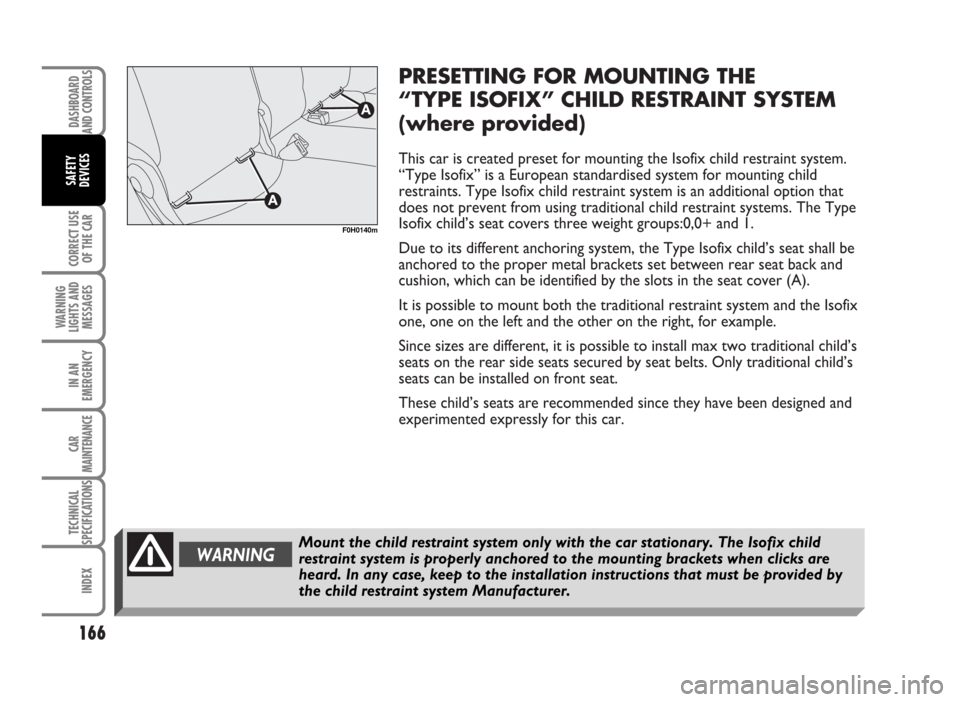
PRESETTING FOR MOUNTING THE
“TYPE ISOFIX” CHILD RESTRAINT SYSTEM
(where provided)
This car is created preset for mounting the Isofix child restraint system.
“Type Isofix” is a European standardised system for mounting child
restraints. Type Isofix child restraint system is an additional option that
does not prevent from using traditional child restraint systems. The Type
Isofix child’s seat covers three weight groups:0,0+ and 1.
Due to its different anchoring system, the Type Isofix child’s seat shall be
anchored to the proper metal brackets set between rear seat back and
cushion, which can be identified by the slots in the seat cover (A).
It is possible to mount both the traditional restraint system and the Isofix
one, one on the left and the other on the right, for example.
Since sizes are different, it is possible to install max two traditional child’s
seats on the rear side seats secured by seat belts. Only traditional child’s
seats can be installed on front seat.
These child’s seats are recommended since they have been designed and
experimented expressly for this car.
166
CORRECT USE
OF THE CAR
WARNING
LIGHTS AND
MESSAGES
IN AN
EMERGENCY
CAR
MAINTENANCE
TECHNICAL
SPECIFICATIONS
INDEX
DASHBOARD
AND CONTROLS
SAFETY
DEVICES
F0H0140m
WARNINGMount the child restraint system only with the car stationary. The Isofix child
restraint system is properly anchored to the mounting brackets when clicks are
heard. In any case, keep to the installation instructions that must be provided by
the child restraint system Manufacturer.
Page 168 of 314
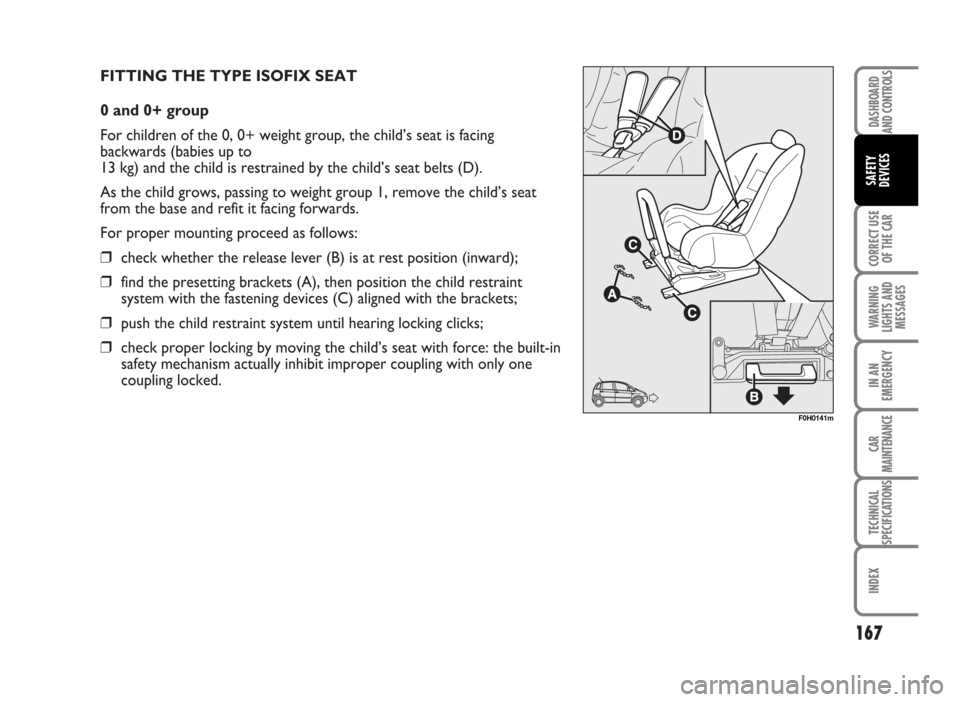
FITTING THE TYPE ISOFIX SEAT
0 and 0+ group
For children of the 0, 0+ weight group, the child’s seat is facing
backwards (babies up to
13 kg) and the child is restrained by the child’s seat belts (D).
As the child grows, passing to weight group 1, remove the child’s seat
from the base and refit it facing forwards.
For proper mounting proceed as follows:
❒check whether the release lever (B) is at rest position (inward);
❒find the presetting brackets (A), then position the child restraint
system with the fastening devices (C) aligned with the brackets;
❒push the child restraint system until hearing locking clicks;
❒check proper locking by moving the child’s seat with force: the built-in
safety mechanism actually inhibit improper coupling with only one
coupling locked.
167
CORRECT USE
OF THE CAR
WARNING
LIGHTS AND
MESSAGES
IN AN
EMERGENCY
CAR
MAINTENANCE
TECHNICAL
SPECIFICATIONS
INDEX
DASHBOARD
AND CONTROLS
SAFETY
DEVICES
F0H0141m
Page 169 of 314
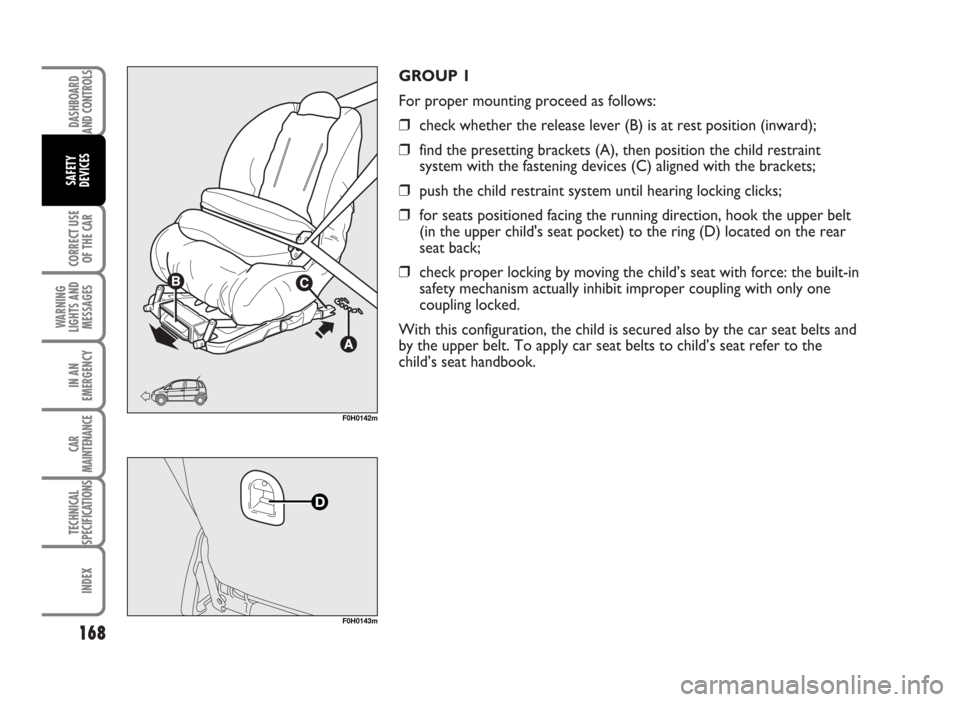
GROUP 1
For proper mounting proceed as follows:
❒check whether the release lever (B) is at rest position (inward);
❒find the presetting brackets (A), then position the child restraint
system with the fastening devices (C) aligned with the brackets;
❒push the child restraint system until hearing locking clicks;
❒for seats positioned facing the running direction, hook the upper belt
(in the upper child's seat pocket) to the ring (D) located on the rear
seat back;
❒check proper locking by moving the child’s seat with force: the built-in
safety mechanism actually inhibit improper coupling with only one
coupling locked.
With this configuration, the child is secured also by the car seat belts and
by the upper belt. To apply car seat belts to child’s seat refer to the
child’s seat handbook.
168
CORRECT USE
OF THE CAR
WARNING
LIGHTS AND
MESSAGES
IN AN
EMERGENCY
CAR
MAINTENANCE
TECHNICAL
SPECIFICATIONS
INDEX
DASHBOARD
AND CONTROLS
SAFETY
DEVICES
F0H0142m
F0H0143m
Page 170 of 314
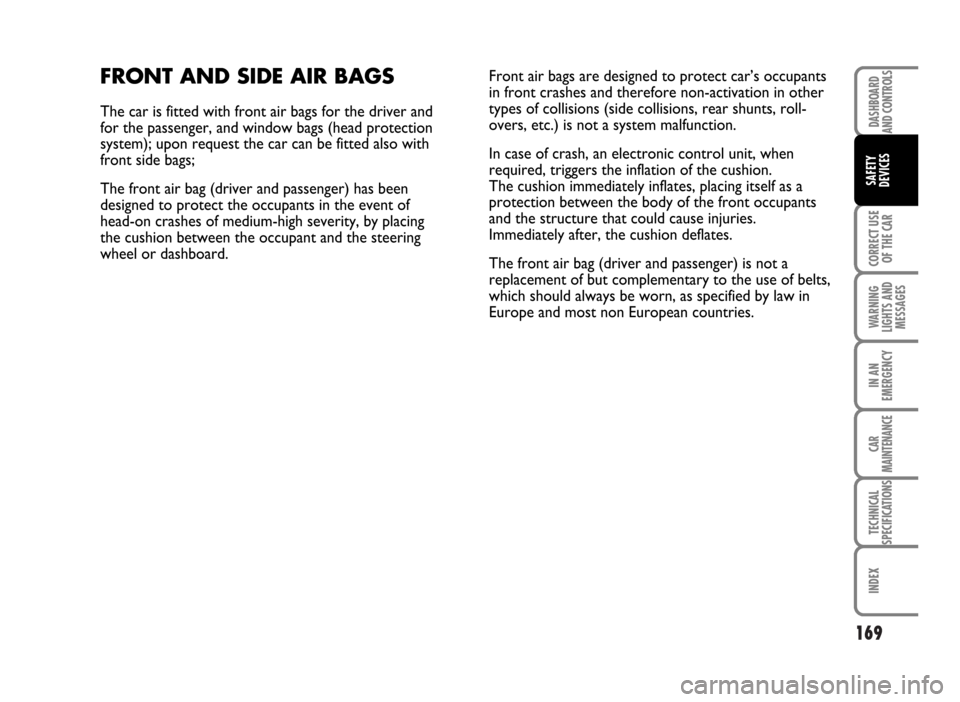
169
CORRECT USE
OF THE CAR
WARNING
LIGHTS AND
MESSAGES
IN AN
EMERGENCY
CAR
MAINTENANCE
TECHNICAL
SPECIFICATIONS
INDEX
DASHBOARD
AND CONTROLS
SAFETY
DEVICES
FRONT AND SIDE AIR BAGS
The car is fitted with front air bags for the driver and
for the passenger, and window bags (head protection
system); upon request the car can be fitted also with
front side bags;
The front air bag (driver and passenger) has been
designed to protect the occupants in the event of
head-on crashes of medium-high severity, by placing
the cushion between the occupant and the steering
wheel or dashboard.Front air bags are designed to protect car’s occupants
in front crashes and therefore non-activation in other
types of collisions (side collisions, rear shunts, roll-
overs, etc.) is not a system malfunction.
In case of crash, an electronic control unit, when
required, triggers the inflation of the cushion.
The cushion immediately inflates, placing itself as a
protection between the body of the front occupants
and the structure that could cause injuries.
Immediately after, the cushion deflates.
The front air bag (driver and passenger) is not a
replacement of but complementary to the use of belts,
which should always be worn, as specified by law in
Europe and most non European countries.